Financial Management Concepts and Applications
VerifiedAdded on 2020/01/16
|15
|5064
|245
Literature Review
AI Summary
This assignment focuses on understanding fundamental financial management principles and their application in diverse business contexts. It covers topics such as capital structure decisions, the life cycle of a firm, energy efficiency in production, and the role of human resource management in corporate strategy. Students are expected to analyze provided case studies and research papers to demonstrate their comprehension of these concepts.
Contribute Materials
Your contribution can guide someone’s learning journey. Share your
documents today.
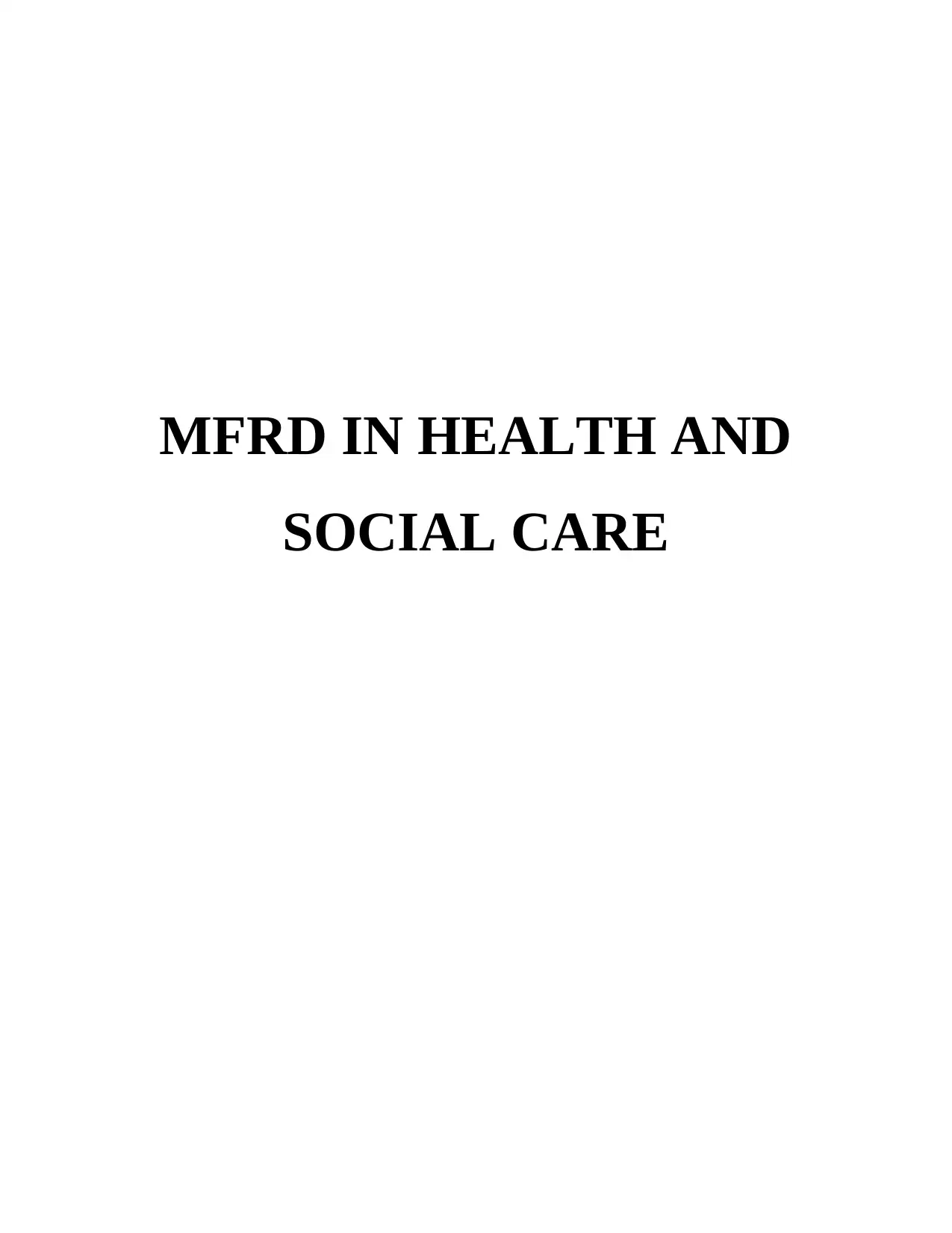
MFRD IN HEALTH AND
SOCIAL CARE
SOCIAL CARE
Secure Best Marks with AI Grader
Need help grading? Try our AI Grader for instant feedback on your assignments.
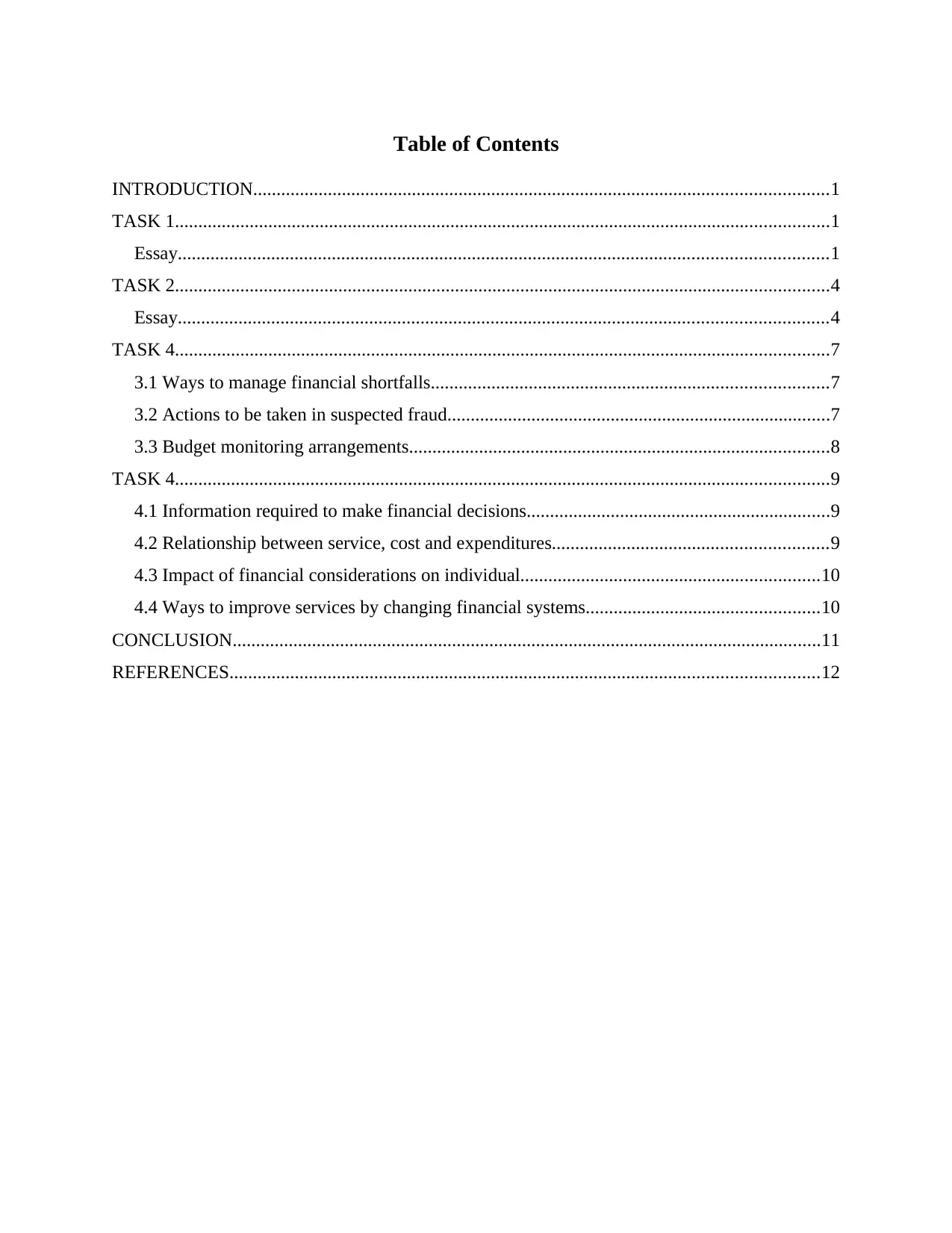
Table of Contents
INTRODUCTION...........................................................................................................................1
TASK 1............................................................................................................................................1
Essay...........................................................................................................................................1
TASK 2............................................................................................................................................4
Essay...........................................................................................................................................4
TASK 4............................................................................................................................................7
3.1 Ways to manage financial shortfalls.....................................................................................7
3.2 Actions to be taken in suspected fraud..................................................................................7
3.3 Budget monitoring arrangements..........................................................................................8
TASK 4............................................................................................................................................9
4.1 Information required to make financial decisions.................................................................9
4.2 Relationship between service, cost and expenditures...........................................................9
4.3 Impact of financial considerations on individual................................................................10
4.4 Ways to improve services by changing financial systems..................................................10
CONCLUSION..............................................................................................................................11
REFERENCES..............................................................................................................................12
INTRODUCTION...........................................................................................................................1
TASK 1............................................................................................................................................1
Essay...........................................................................................................................................1
TASK 2............................................................................................................................................4
Essay...........................................................................................................................................4
TASK 4............................................................................................................................................7
3.1 Ways to manage financial shortfalls.....................................................................................7
3.2 Actions to be taken in suspected fraud..................................................................................7
3.3 Budget monitoring arrangements..........................................................................................8
TASK 4............................................................................................................................................9
4.1 Information required to make financial decisions.................................................................9
4.2 Relationship between service, cost and expenditures...........................................................9
4.3 Impact of financial considerations on individual................................................................10
4.4 Ways to improve services by changing financial systems..................................................10
CONCLUSION..............................................................................................................................11
REFERENCES..............................................................................................................................12

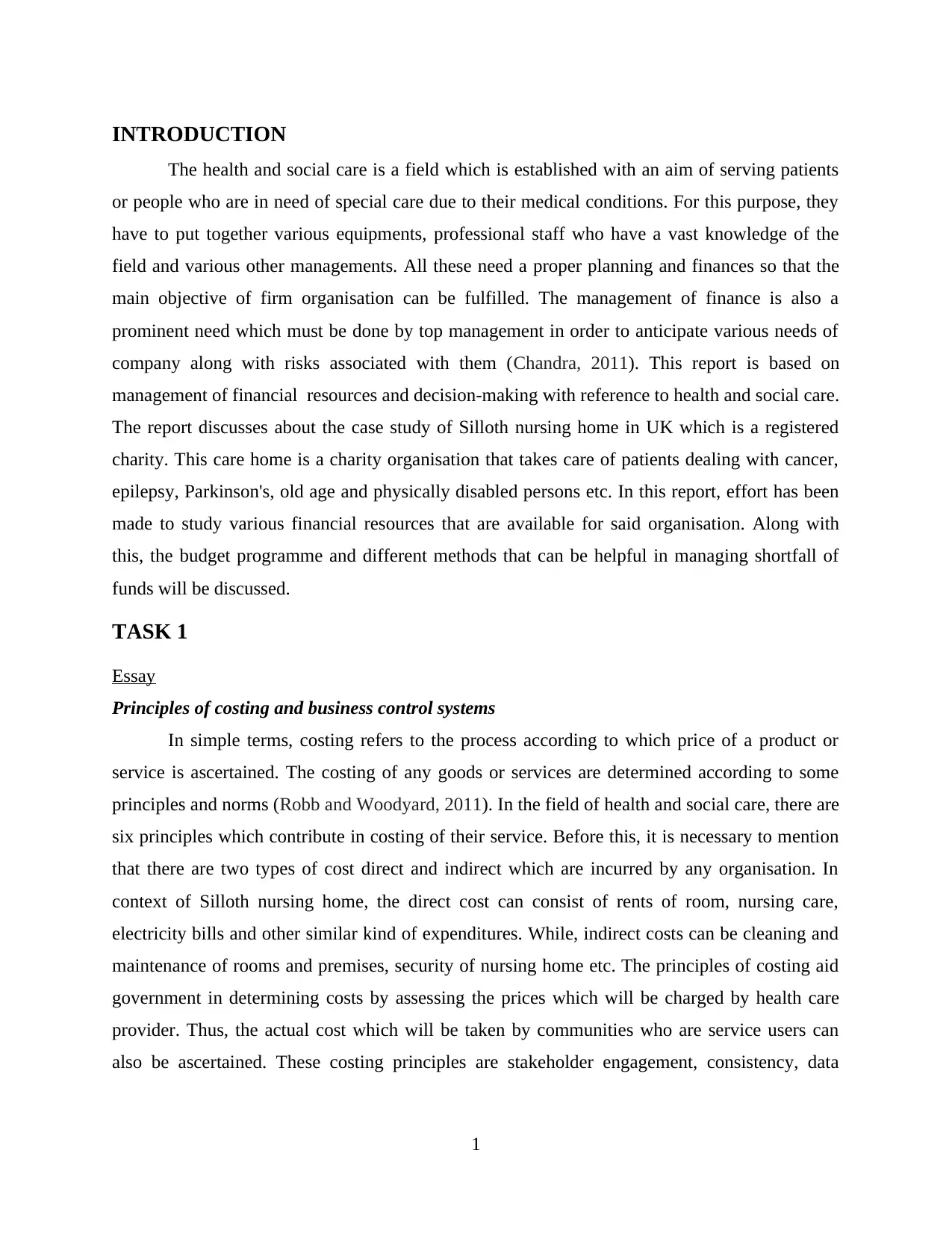
INTRODUCTION
The health and social care is a field which is established with an aim of serving patients
or people who are in need of special care due to their medical conditions. For this purpose, they
have to put together various equipments, professional staff who have a vast knowledge of the
field and various other managements. All these need a proper planning and finances so that the
main objective of firm organisation can be fulfilled. The management of finance is also a
prominent need which must be done by top management in order to anticipate various needs of
company along with risks associated with them (Chandra, 2011). This report is based on
management of financial resources and decision-making with reference to health and social care.
The report discusses about the case study of Silloth nursing home in UK which is a registered
charity. This care home is a charity organisation that takes care of patients dealing with cancer,
epilepsy, Parkinson's, old age and physically disabled persons etc. In this report, effort has been
made to study various financial resources that are available for said organisation. Along with
this, the budget programme and different methods that can be helpful in managing shortfall of
funds will be discussed.
TASK 1
Essay
Principles of costing and business control systems
In simple terms, costing refers to the process according to which price of a product or
service is ascertained. The costing of any goods or services are determined according to some
principles and norms (Robb and Woodyard, 2011). In the field of health and social care, there are
six principles which contribute in costing of their service. Before this, it is necessary to mention
that there are two types of cost direct and indirect which are incurred by any organisation. In
context of Silloth nursing home, the direct cost can consist of rents of room, nursing care,
electricity bills and other similar kind of expenditures. While, indirect costs can be cleaning and
maintenance of rooms and premises, security of nursing home etc. The principles of costing aid
government in determining costs by assessing the prices which will be charged by health care
provider. Thus, the actual cost which will be taken by communities who are service users can
also be ascertained. These costing principles are stakeholder engagement, consistency, data
1
The health and social care is a field which is established with an aim of serving patients
or people who are in need of special care due to their medical conditions. For this purpose, they
have to put together various equipments, professional staff who have a vast knowledge of the
field and various other managements. All these need a proper planning and finances so that the
main objective of firm organisation can be fulfilled. The management of finance is also a
prominent need which must be done by top management in order to anticipate various needs of
company along with risks associated with them (Chandra, 2011). This report is based on
management of financial resources and decision-making with reference to health and social care.
The report discusses about the case study of Silloth nursing home in UK which is a registered
charity. This care home is a charity organisation that takes care of patients dealing with cancer,
epilepsy, Parkinson's, old age and physically disabled persons etc. In this report, effort has been
made to study various financial resources that are available for said organisation. Along with
this, the budget programme and different methods that can be helpful in managing shortfall of
funds will be discussed.
TASK 1
Essay
Principles of costing and business control systems
In simple terms, costing refers to the process according to which price of a product or
service is ascertained. The costing of any goods or services are determined according to some
principles and norms (Robb and Woodyard, 2011). In the field of health and social care, there are
six principles which contribute in costing of their service. Before this, it is necessary to mention
that there are two types of cost direct and indirect which are incurred by any organisation. In
context of Silloth nursing home, the direct cost can consist of rents of room, nursing care,
electricity bills and other similar kind of expenditures. While, indirect costs can be cleaning and
maintenance of rooms and premises, security of nursing home etc. The principles of costing aid
government in determining costs by assessing the prices which will be charged by health care
provider. Thus, the actual cost which will be taken by communities who are service users can
also be ascertained. These costing principles are stakeholder engagement, consistency, data
1
Secure Best Marks with AI Grader
Need help grading? Try our AI Grader for instant feedback on your assignments.
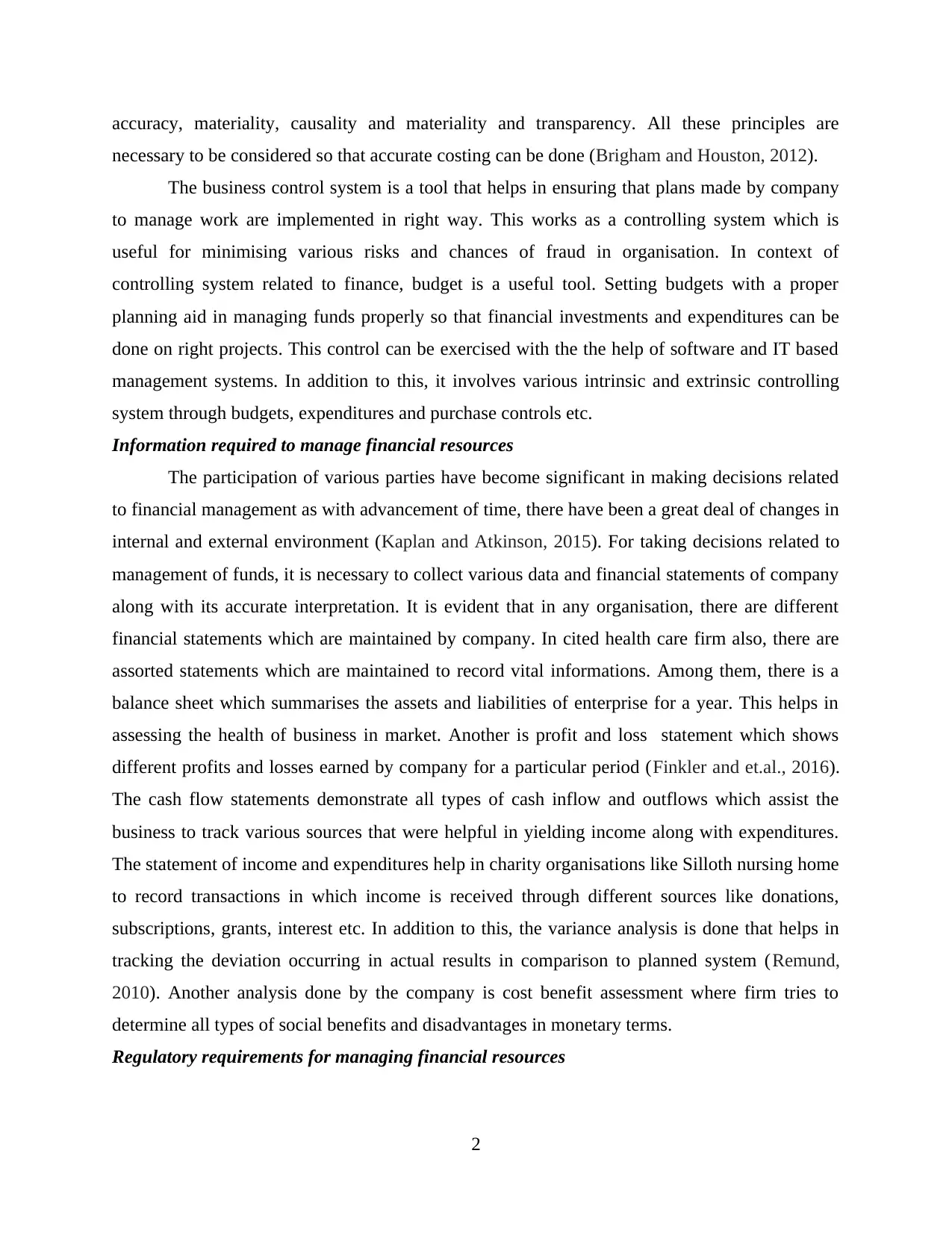
accuracy, materiality, causality and materiality and transparency. All these principles are
necessary to be considered so that accurate costing can be done (Brigham and Houston, 2012).
The business control system is a tool that helps in ensuring that plans made by company
to manage work are implemented in right way. This works as a controlling system which is
useful for minimising various risks and chances of fraud in organisation. In context of
controlling system related to finance, budget is a useful tool. Setting budgets with a proper
planning aid in managing funds properly so that financial investments and expenditures can be
done on right projects. This control can be exercised with the the help of software and IT based
management systems. In addition to this, it involves various intrinsic and extrinsic controlling
system through budgets, expenditures and purchase controls etc.
Information required to manage financial resources
The participation of various parties have become significant in making decisions related
to financial management as with advancement of time, there have been a great deal of changes in
internal and external environment (Kaplan and Atkinson, 2015). For taking decisions related to
management of funds, it is necessary to collect various data and financial statements of company
along with its accurate interpretation. It is evident that in any organisation, there are different
financial statements which are maintained by company. In cited health care firm also, there are
assorted statements which are maintained to record vital informations. Among them, there is a
balance sheet which summarises the assets and liabilities of enterprise for a year. This helps in
assessing the health of business in market. Another is profit and loss statement which shows
different profits and losses earned by company for a particular period (Finkler and et.al., 2016).
The cash flow statements demonstrate all types of cash inflow and outflows which assist the
business to track various sources that were helpful in yielding income along with expenditures.
The statement of income and expenditures help in charity organisations like Silloth nursing home
to record transactions in which income is received through different sources like donations,
subscriptions, grants, interest etc. In addition to this, the variance analysis is done that helps in
tracking the deviation occurring in actual results in comparison to planned system (Remund,
2010). Another analysis done by the company is cost benefit assessment where firm tries to
determine all types of social benefits and disadvantages in monetary terms.
Regulatory requirements for managing financial resources
2
necessary to be considered so that accurate costing can be done (Brigham and Houston, 2012).
The business control system is a tool that helps in ensuring that plans made by company
to manage work are implemented in right way. This works as a controlling system which is
useful for minimising various risks and chances of fraud in organisation. In context of
controlling system related to finance, budget is a useful tool. Setting budgets with a proper
planning aid in managing funds properly so that financial investments and expenditures can be
done on right projects. This control can be exercised with the the help of software and IT based
management systems. In addition to this, it involves various intrinsic and extrinsic controlling
system through budgets, expenditures and purchase controls etc.
Information required to manage financial resources
The participation of various parties have become significant in making decisions related
to financial management as with advancement of time, there have been a great deal of changes in
internal and external environment (Kaplan and Atkinson, 2015). For taking decisions related to
management of funds, it is necessary to collect various data and financial statements of company
along with its accurate interpretation. It is evident that in any organisation, there are different
financial statements which are maintained by company. In cited health care firm also, there are
assorted statements which are maintained to record vital informations. Among them, there is a
balance sheet which summarises the assets and liabilities of enterprise for a year. This helps in
assessing the health of business in market. Another is profit and loss statement which shows
different profits and losses earned by company for a particular period (Finkler and et.al., 2016).
The cash flow statements demonstrate all types of cash inflow and outflows which assist the
business to track various sources that were helpful in yielding income along with expenditures.
The statement of income and expenditures help in charity organisations like Silloth nursing home
to record transactions in which income is received through different sources like donations,
subscriptions, grants, interest etc. In addition to this, the variance analysis is done that helps in
tracking the deviation occurring in actual results in comparison to planned system (Remund,
2010). Another analysis done by the company is cost benefit assessment where firm tries to
determine all types of social benefits and disadvantages in monetary terms.
Regulatory requirements for managing financial resources
2
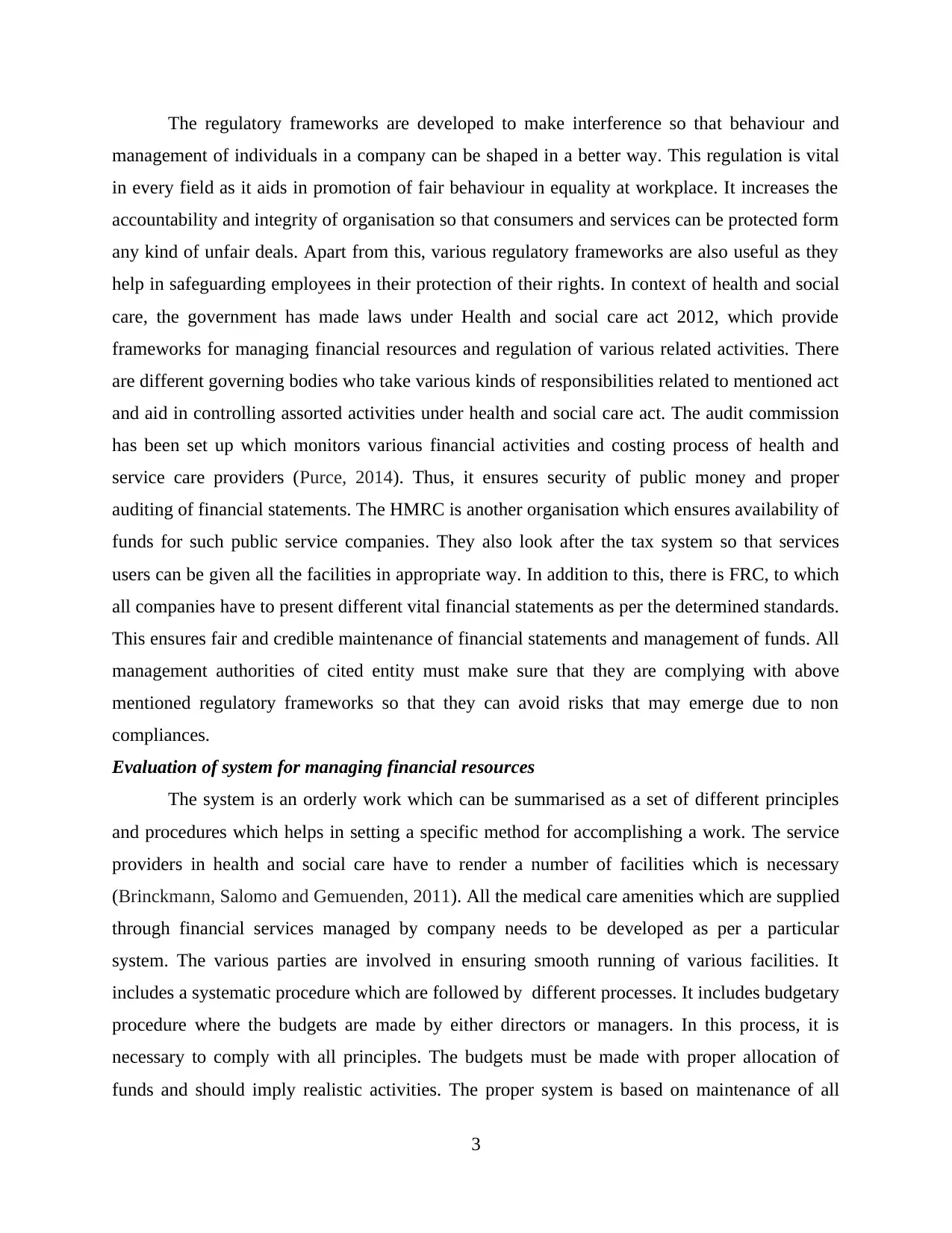
The regulatory frameworks are developed to make interference so that behaviour and
management of individuals in a company can be shaped in a better way. This regulation is vital
in every field as it aids in promotion of fair behaviour in equality at workplace. It increases the
accountability and integrity of organisation so that consumers and services can be protected form
any kind of unfair deals. Apart from this, various regulatory frameworks are also useful as they
help in safeguarding employees in their protection of their rights. In context of health and social
care, the government has made laws under Health and social care act 2012, which provide
frameworks for managing financial resources and regulation of various related activities. There
are different governing bodies who take various kinds of responsibilities related to mentioned act
and aid in controlling assorted activities under health and social care act. The audit commission
has been set up which monitors various financial activities and costing process of health and
service care providers (Purce, 2014). Thus, it ensures security of public money and proper
auditing of financial statements. The HMRC is another organisation which ensures availability of
funds for such public service companies. They also look after the tax system so that services
users can be given all the facilities in appropriate way. In addition to this, there is FRC, to which
all companies have to present different vital financial statements as per the determined standards.
This ensures fair and credible maintenance of financial statements and management of funds. All
management authorities of cited entity must make sure that they are complying with above
mentioned regulatory frameworks so that they can avoid risks that may emerge due to non
compliances.
Evaluation of system for managing financial resources
The system is an orderly work which can be summarised as a set of different principles
and procedures which helps in setting a specific method for accomplishing a work. The service
providers in health and social care have to render a number of facilities which is necessary
(Brinckmann, Salomo and Gemuenden, 2011). All the medical care amenities which are supplied
through financial services managed by company needs to be developed as per a particular
system. The various parties are involved in ensuring smooth running of various facilities. It
includes a systematic procedure which are followed by different processes. It includes budgetary
procedure where the budgets are made by either directors or managers. In this process, it is
necessary to comply with all principles. The budgets must be made with proper allocation of
funds and should imply realistic activities. The proper system is based on maintenance of all
3
management of individuals in a company can be shaped in a better way. This regulation is vital
in every field as it aids in promotion of fair behaviour in equality at workplace. It increases the
accountability and integrity of organisation so that consumers and services can be protected form
any kind of unfair deals. Apart from this, various regulatory frameworks are also useful as they
help in safeguarding employees in their protection of their rights. In context of health and social
care, the government has made laws under Health and social care act 2012, which provide
frameworks for managing financial resources and regulation of various related activities. There
are different governing bodies who take various kinds of responsibilities related to mentioned act
and aid in controlling assorted activities under health and social care act. The audit commission
has been set up which monitors various financial activities and costing process of health and
service care providers (Purce, 2014). Thus, it ensures security of public money and proper
auditing of financial statements. The HMRC is another organisation which ensures availability of
funds for such public service companies. They also look after the tax system so that services
users can be given all the facilities in appropriate way. In addition to this, there is FRC, to which
all companies have to present different vital financial statements as per the determined standards.
This ensures fair and credible maintenance of financial statements and management of funds. All
management authorities of cited entity must make sure that they are complying with above
mentioned regulatory frameworks so that they can avoid risks that may emerge due to non
compliances.
Evaluation of system for managing financial resources
The system is an orderly work which can be summarised as a set of different principles
and procedures which helps in setting a specific method for accomplishing a work. The service
providers in health and social care have to render a number of facilities which is necessary
(Brinckmann, Salomo and Gemuenden, 2011). All the medical care amenities which are supplied
through financial services managed by company needs to be developed as per a particular
system. The various parties are involved in ensuring smooth running of various facilities. It
includes a systematic procedure which are followed by different processes. It includes budgetary
procedure where the budgets are made by either directors or managers. In this process, it is
necessary to comply with all principles. The budgets must be made with proper allocation of
funds and should imply realistic activities. The proper system is based on maintenance of all
3
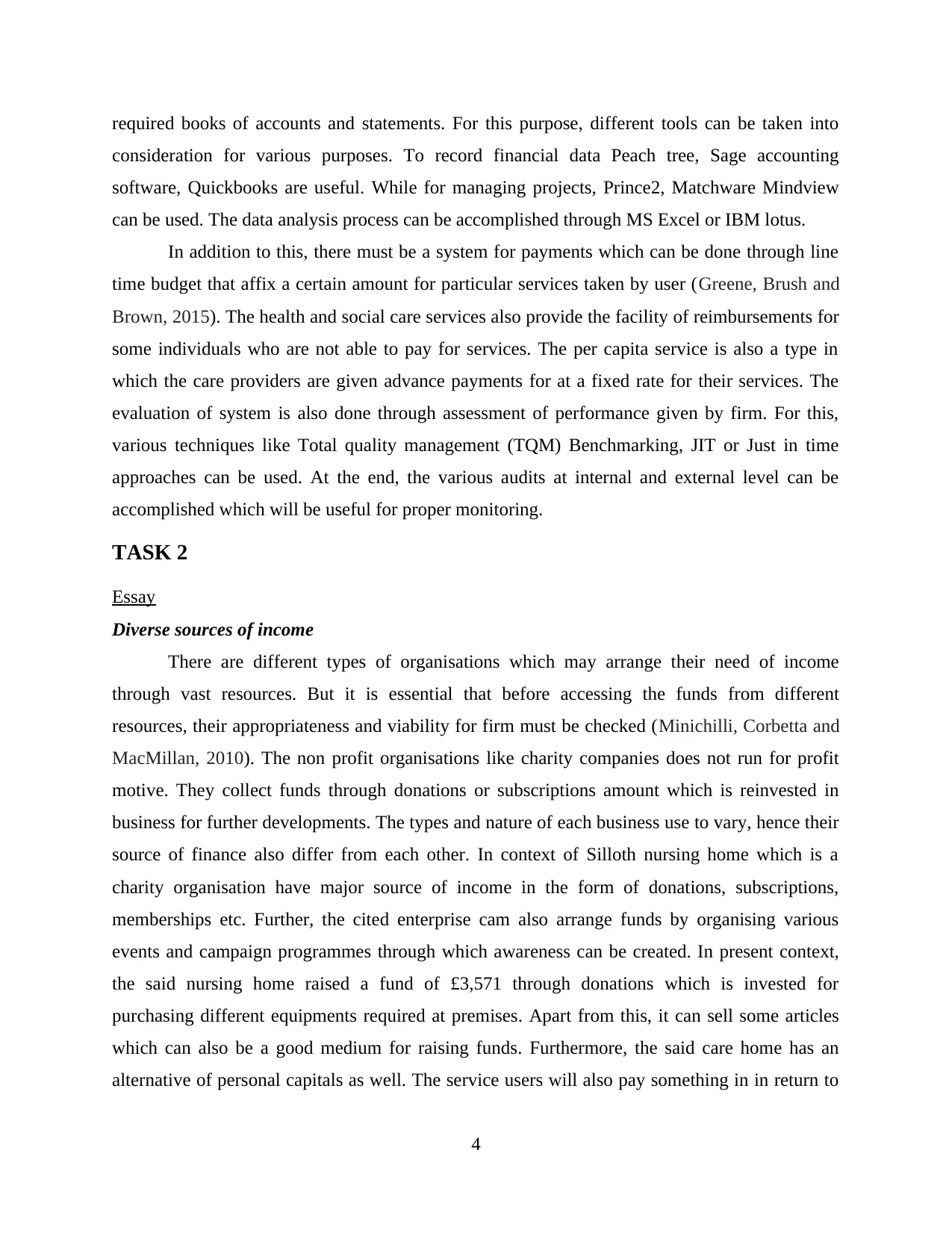
required books of accounts and statements. For this purpose, different tools can be taken into
consideration for various purposes. To record financial data Peach tree, Sage accounting
software, Quickbooks are useful. While for managing projects, Prince2, Matchware Mindview
can be used. The data analysis process can be accomplished through MS Excel or IBM lotus.
In addition to this, there must be a system for payments which can be done through line
time budget that affix a certain amount for particular services taken by user (Greene, Brush and
Brown, 2015). The health and social care services also provide the facility of reimbursements for
some individuals who are not able to pay for services. The per capita service is also a type in
which the care providers are given advance payments for at a fixed rate for their services. The
evaluation of system is also done through assessment of performance given by firm. For this,
various techniques like Total quality management (TQM) Benchmarking, JIT or Just in time
approaches can be used. At the end, the various audits at internal and external level can be
accomplished which will be useful for proper monitoring.
TASK 2
Essay
Diverse sources of income
There are different types of organisations which may arrange their need of income
through vast resources. But it is essential that before accessing the funds from different
resources, their appropriateness and viability for firm must be checked (Minichilli, Corbetta and
MacMillan, 2010). The non profit organisations like charity companies does not run for profit
motive. They collect funds through donations or subscriptions amount which is reinvested in
business for further developments. The types and nature of each business use to vary, hence their
source of finance also differ from each other. In context of Silloth nursing home which is a
charity organisation have major source of income in the form of donations, subscriptions,
memberships etc. Further, the cited enterprise cam also arrange funds by organising various
events and campaign programmes through which awareness can be created. In present context,
the said nursing home raised a fund of £3,571 through donations which is invested for
purchasing different equipments required at premises. Apart from this, it can sell some articles
which can also be a good medium for raising funds. Furthermore, the said care home has an
alternative of personal capitals as well. The service users will also pay something in in return to
4
consideration for various purposes. To record financial data Peach tree, Sage accounting
software, Quickbooks are useful. While for managing projects, Prince2, Matchware Mindview
can be used. The data analysis process can be accomplished through MS Excel or IBM lotus.
In addition to this, there must be a system for payments which can be done through line
time budget that affix a certain amount for particular services taken by user (Greene, Brush and
Brown, 2015). The health and social care services also provide the facility of reimbursements for
some individuals who are not able to pay for services. The per capita service is also a type in
which the care providers are given advance payments for at a fixed rate for their services. The
evaluation of system is also done through assessment of performance given by firm. For this,
various techniques like Total quality management (TQM) Benchmarking, JIT or Just in time
approaches can be used. At the end, the various audits at internal and external level can be
accomplished which will be useful for proper monitoring.
TASK 2
Essay
Diverse sources of income
There are different types of organisations which may arrange their need of income
through vast resources. But it is essential that before accessing the funds from different
resources, their appropriateness and viability for firm must be checked (Minichilli, Corbetta and
MacMillan, 2010). The non profit organisations like charity companies does not run for profit
motive. They collect funds through donations or subscriptions amount which is reinvested in
business for further developments. The types and nature of each business use to vary, hence their
source of finance also differ from each other. In context of Silloth nursing home which is a
charity organisation have major source of income in the form of donations, subscriptions,
memberships etc. Further, the cited enterprise cam also arrange funds by organising various
events and campaign programmes through which awareness can be created. In present context,
the said nursing home raised a fund of £3,571 through donations which is invested for
purchasing different equipments required at premises. Apart from this, it can sell some articles
which can also be a good medium for raising funds. Furthermore, the said care home has an
alternative of personal capitals as well. The service users will also pay something in in return to
4
Paraphrase This Document
Need a fresh take? Get an instant paraphrase of this document with our AI Paraphraser
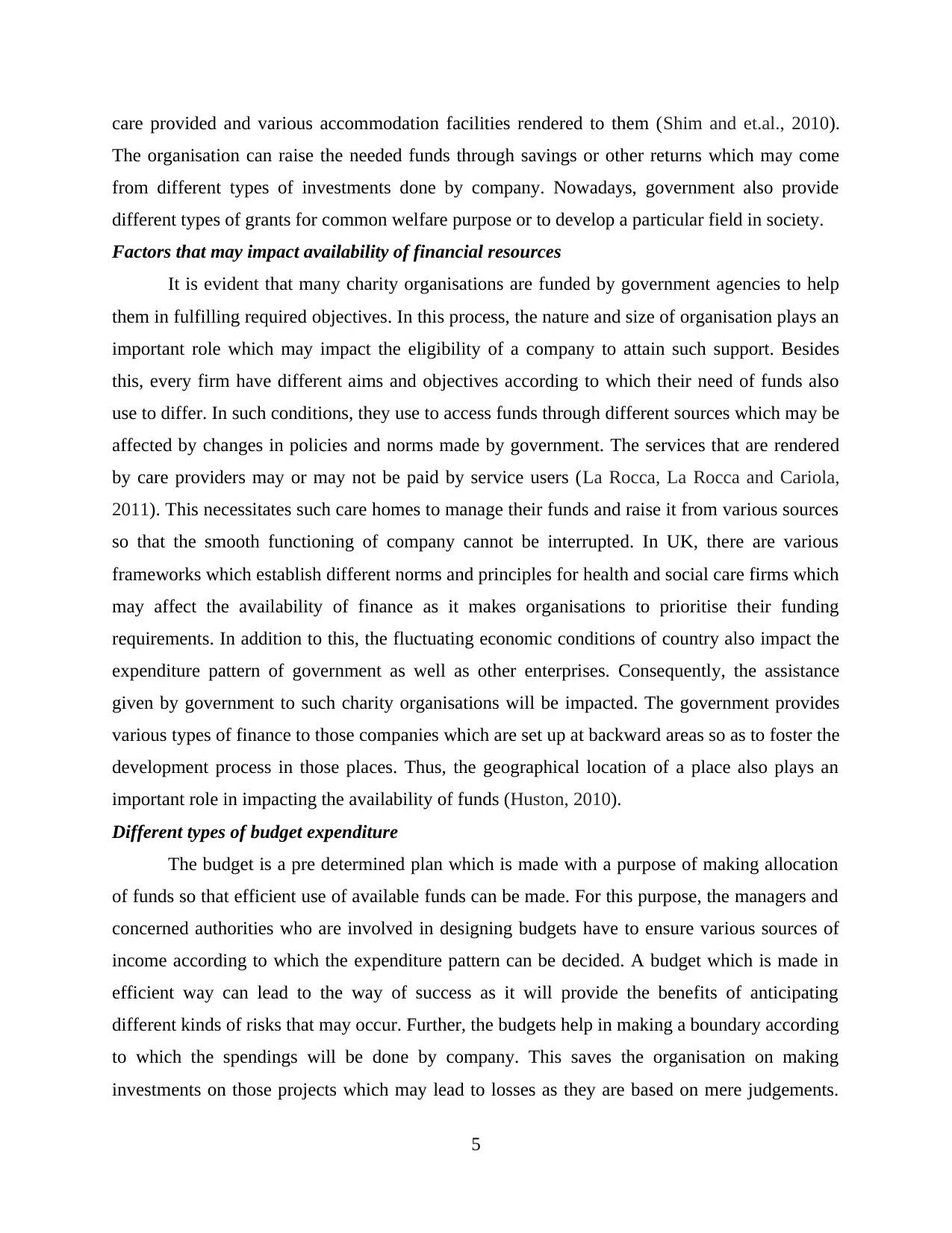
care provided and various accommodation facilities rendered to them (Shim and et.al., 2010).
The organisation can raise the needed funds through savings or other returns which may come
from different types of investments done by company. Nowadays, government also provide
different types of grants for common welfare purpose or to develop a particular field in society.
Factors that may impact availability of financial resources
It is evident that many charity organisations are funded by government agencies to help
them in fulfilling required objectives. In this process, the nature and size of organisation plays an
important role which may impact the eligibility of a company to attain such support. Besides
this, every firm have different aims and objectives according to which their need of funds also
use to differ. In such conditions, they use to access funds through different sources which may be
affected by changes in policies and norms made by government. The services that are rendered
by care providers may or may not be paid by service users (La Rocca, La Rocca and Cariola,
2011). This necessitates such care homes to manage their funds and raise it from various sources
so that the smooth functioning of company cannot be interrupted. In UK, there are various
frameworks which establish different norms and principles for health and social care firms which
may affect the availability of finance as it makes organisations to prioritise their funding
requirements. In addition to this, the fluctuating economic conditions of country also impact the
expenditure pattern of government as well as other enterprises. Consequently, the assistance
given by government to such charity organisations will be impacted. The government provides
various types of finance to those companies which are set up at backward areas so as to foster the
development process in those places. Thus, the geographical location of a place also plays an
important role in impacting the availability of funds (Huston, 2010).
Different types of budget expenditure
The budget is a pre determined plan which is made with a purpose of making allocation
of funds so that efficient use of available funds can be made. For this purpose, the managers and
concerned authorities who are involved in designing budgets have to ensure various sources of
income according to which the expenditure pattern can be decided. A budget which is made in
efficient way can lead to the way of success as it will provide the benefits of anticipating
different kinds of risks that may occur. Further, the budgets help in making a boundary according
to which the spendings will be done by company. This saves the organisation on making
investments on those projects which may lead to losses as they are based on mere judgements.
5
The organisation can raise the needed funds through savings or other returns which may come
from different types of investments done by company. Nowadays, government also provide
different types of grants for common welfare purpose or to develop a particular field in society.
Factors that may impact availability of financial resources
It is evident that many charity organisations are funded by government agencies to help
them in fulfilling required objectives. In this process, the nature and size of organisation plays an
important role which may impact the eligibility of a company to attain such support. Besides
this, every firm have different aims and objectives according to which their need of funds also
use to differ. In such conditions, they use to access funds through different sources which may be
affected by changes in policies and norms made by government. The services that are rendered
by care providers may or may not be paid by service users (La Rocca, La Rocca and Cariola,
2011). This necessitates such care homes to manage their funds and raise it from various sources
so that the smooth functioning of company cannot be interrupted. In UK, there are various
frameworks which establish different norms and principles for health and social care firms which
may affect the availability of finance as it makes organisations to prioritise their funding
requirements. In addition to this, the fluctuating economic conditions of country also impact the
expenditure pattern of government as well as other enterprises. Consequently, the assistance
given by government to such charity organisations will be impacted. The government provides
various types of finance to those companies which are set up at backward areas so as to foster the
development process in those places. Thus, the geographical location of a place also plays an
important role in impacting the availability of funds (Huston, 2010).
Different types of budget expenditure
The budget is a pre determined plan which is made with a purpose of making allocation
of funds so that efficient use of available funds can be made. For this purpose, the managers and
concerned authorities who are involved in designing budgets have to ensure various sources of
income according to which the expenditure pattern can be decided. A budget which is made in
efficient way can lead to the way of success as it will provide the benefits of anticipating
different kinds of risks that may occur. Further, the budgets help in making a boundary according
to which the spendings will be done by company. This saves the organisation on making
investments on those projects which may lead to losses as they are based on mere judgements.
5
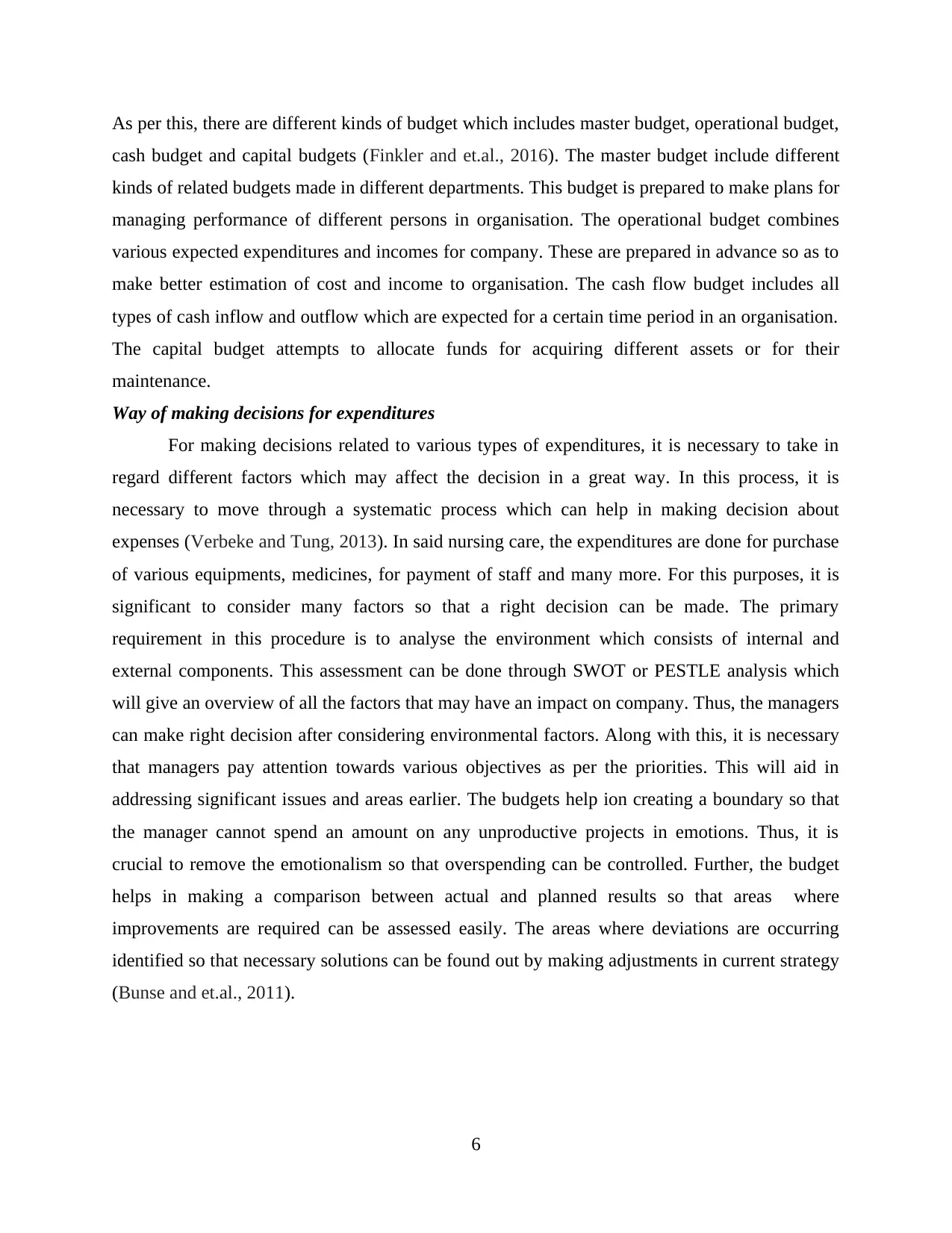
As per this, there are different kinds of budget which includes master budget, operational budget,
cash budget and capital budgets (Finkler and et.al., 2016). The master budget include different
kinds of related budgets made in different departments. This budget is prepared to make plans for
managing performance of different persons in organisation. The operational budget combines
various expected expenditures and incomes for company. These are prepared in advance so as to
make better estimation of cost and income to organisation. The cash flow budget includes all
types of cash inflow and outflow which are expected for a certain time period in an organisation.
The capital budget attempts to allocate funds for acquiring different assets or for their
maintenance.
Way of making decisions for expenditures
For making decisions related to various types of expenditures, it is necessary to take in
regard different factors which may affect the decision in a great way. In this process, it is
necessary to move through a systematic process which can help in making decision about
expenses (Verbeke and Tung, 2013). In said nursing care, the expenditures are done for purchase
of various equipments, medicines, for payment of staff and many more. For this purposes, it is
significant to consider many factors so that a right decision can be made. The primary
requirement in this procedure is to analyse the environment which consists of internal and
external components. This assessment can be done through SWOT or PESTLE analysis which
will give an overview of all the factors that may have an impact on company. Thus, the managers
can make right decision after considering environmental factors. Along with this, it is necessary
that managers pay attention towards various objectives as per the priorities. This will aid in
addressing significant issues and areas earlier. The budgets help ion creating a boundary so that
the manager cannot spend an amount on any unproductive projects in emotions. Thus, it is
crucial to remove the emotionalism so that overspending can be controlled. Further, the budget
helps in making a comparison between actual and planned results so that areas where
improvements are required can be assessed easily. The areas where deviations are occurring
identified so that necessary solutions can be found out by making adjustments in current strategy
(Bunse and et.al., 2011).
6
cash budget and capital budgets (Finkler and et.al., 2016). The master budget include different
kinds of related budgets made in different departments. This budget is prepared to make plans for
managing performance of different persons in organisation. The operational budget combines
various expected expenditures and incomes for company. These are prepared in advance so as to
make better estimation of cost and income to organisation. The cash flow budget includes all
types of cash inflow and outflow which are expected for a certain time period in an organisation.
The capital budget attempts to allocate funds for acquiring different assets or for their
maintenance.
Way of making decisions for expenditures
For making decisions related to various types of expenditures, it is necessary to take in
regard different factors which may affect the decision in a great way. In this process, it is
necessary to move through a systematic process which can help in making decision about
expenses (Verbeke and Tung, 2013). In said nursing care, the expenditures are done for purchase
of various equipments, medicines, for payment of staff and many more. For this purposes, it is
significant to consider many factors so that a right decision can be made. The primary
requirement in this procedure is to analyse the environment which consists of internal and
external components. This assessment can be done through SWOT or PESTLE analysis which
will give an overview of all the factors that may have an impact on company. Thus, the managers
can make right decision after considering environmental factors. Along with this, it is necessary
that managers pay attention towards various objectives as per the priorities. This will aid in
addressing significant issues and areas earlier. The budgets help ion creating a boundary so that
the manager cannot spend an amount on any unproductive projects in emotions. Thus, it is
crucial to remove the emotionalism so that overspending can be controlled. Further, the budget
helps in making a comparison between actual and planned results so that areas where
improvements are required can be assessed easily. The areas where deviations are occurring
identified so that necessary solutions can be found out by making adjustments in current strategy
(Bunse and et.al., 2011).
6
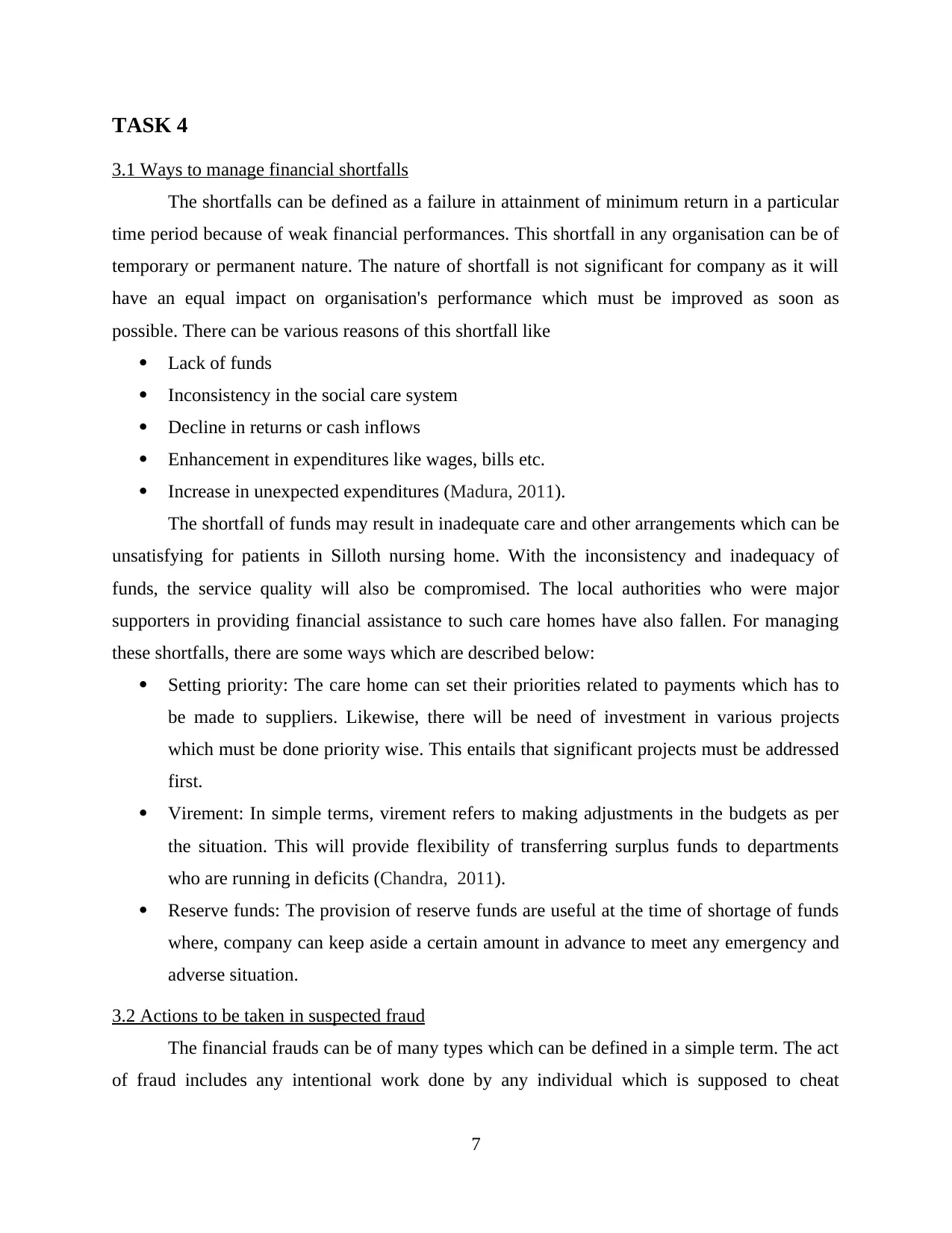
TASK 4
3.1 Ways to manage financial shortfalls
The shortfalls can be defined as a failure in attainment of minimum return in a particular
time period because of weak financial performances. This shortfall in any organisation can be of
temporary or permanent nature. The nature of shortfall is not significant for company as it will
have an equal impact on organisation's performance which must be improved as soon as
possible. There can be various reasons of this shortfall like
Lack of funds
Inconsistency in the social care system
Decline in returns or cash inflows
Enhancement in expenditures like wages, bills etc.
Increase in unexpected expenditures (Madura, 2011).
The shortfall of funds may result in inadequate care and other arrangements which can be
unsatisfying for patients in Silloth nursing home. With the inconsistency and inadequacy of
funds, the service quality will also be compromised. The local authorities who were major
supporters in providing financial assistance to such care homes have also fallen. For managing
these shortfalls, there are some ways which are described below:
Setting priority: The care home can set their priorities related to payments which has to
be made to suppliers. Likewise, there will be need of investment in various projects
which must be done priority wise. This entails that significant projects must be addressed
first.
Virement: In simple terms, virement refers to making adjustments in the budgets as per
the situation. This will provide flexibility of transferring surplus funds to departments
who are running in deficits (Chandra, 2011).
Reserve funds: The provision of reserve funds are useful at the time of shortage of funds
where, company can keep aside a certain amount in advance to meet any emergency and
adverse situation.
3.2 Actions to be taken in suspected fraud
The financial frauds can be of many types which can be defined in a simple term. The act
of fraud includes any intentional work done by any individual which is supposed to cheat
7
3.1 Ways to manage financial shortfalls
The shortfalls can be defined as a failure in attainment of minimum return in a particular
time period because of weak financial performances. This shortfall in any organisation can be of
temporary or permanent nature. The nature of shortfall is not significant for company as it will
have an equal impact on organisation's performance which must be improved as soon as
possible. There can be various reasons of this shortfall like
Lack of funds
Inconsistency in the social care system
Decline in returns or cash inflows
Enhancement in expenditures like wages, bills etc.
Increase in unexpected expenditures (Madura, 2011).
The shortfall of funds may result in inadequate care and other arrangements which can be
unsatisfying for patients in Silloth nursing home. With the inconsistency and inadequacy of
funds, the service quality will also be compromised. The local authorities who were major
supporters in providing financial assistance to such care homes have also fallen. For managing
these shortfalls, there are some ways which are described below:
Setting priority: The care home can set their priorities related to payments which has to
be made to suppliers. Likewise, there will be need of investment in various projects
which must be done priority wise. This entails that significant projects must be addressed
first.
Virement: In simple terms, virement refers to making adjustments in the budgets as per
the situation. This will provide flexibility of transferring surplus funds to departments
who are running in deficits (Chandra, 2011).
Reserve funds: The provision of reserve funds are useful at the time of shortage of funds
where, company can keep aside a certain amount in advance to meet any emergency and
adverse situation.
3.2 Actions to be taken in suspected fraud
The financial frauds can be of many types which can be defined in a simple term. The act
of fraud includes any intentional work done by any individual which is supposed to cheat
7
Secure Best Marks with AI Grader
Need help grading? Try our AI Grader for instant feedback on your assignments.
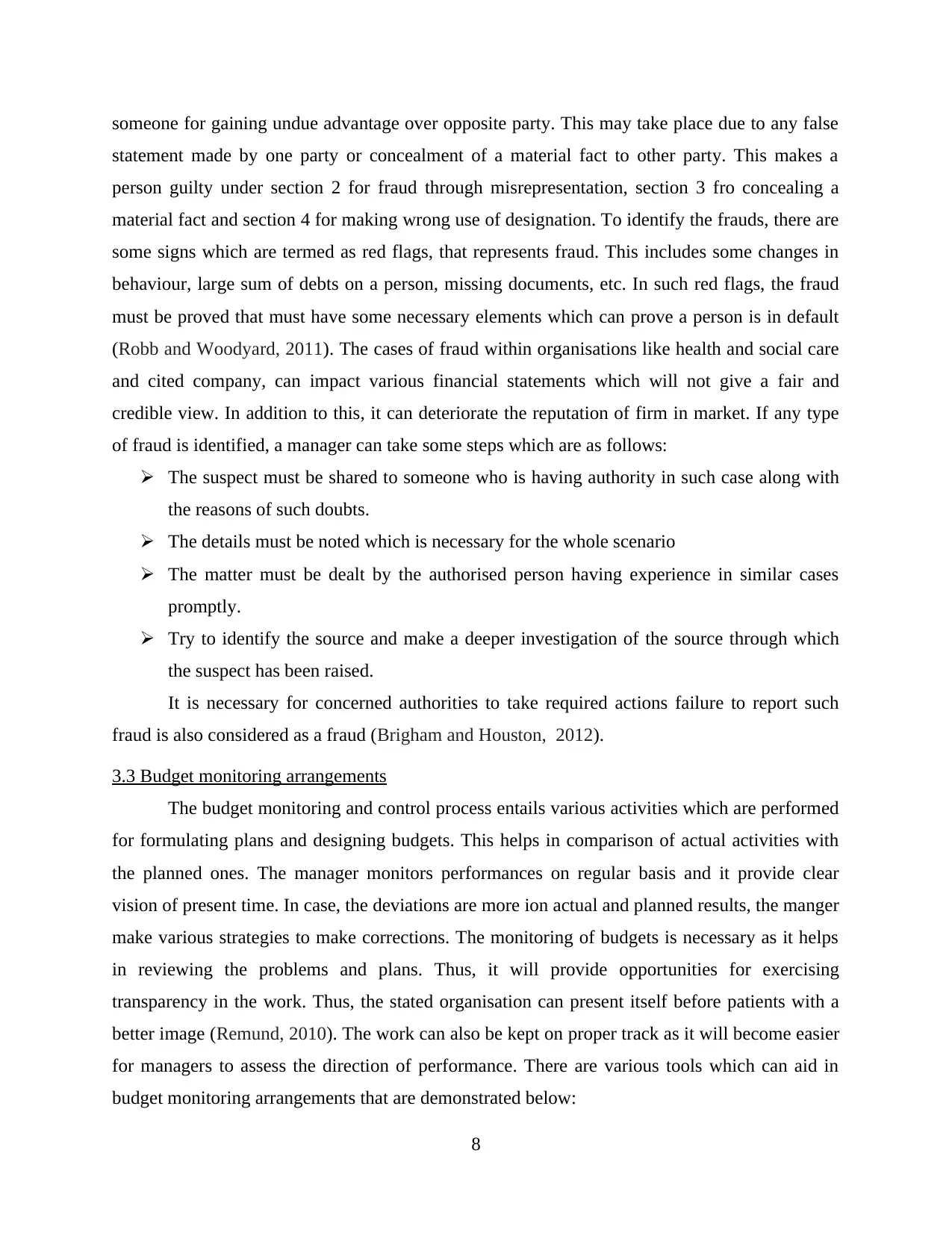
someone for gaining undue advantage over opposite party. This may take place due to any false
statement made by one party or concealment of a material fact to other party. This makes a
person guilty under section 2 for fraud through misrepresentation, section 3 fro concealing a
material fact and section 4 for making wrong use of designation. To identify the frauds, there are
some signs which are termed as red flags, that represents fraud. This includes some changes in
behaviour, large sum of debts on a person, missing documents, etc. In such red flags, the fraud
must be proved that must have some necessary elements which can prove a person is in default
(Robb and Woodyard, 2011). The cases of fraud within organisations like health and social care
and cited company, can impact various financial statements which will not give a fair and
credible view. In addition to this, it can deteriorate the reputation of firm in market. If any type
of fraud is identified, a manager can take some steps which are as follows:
The suspect must be shared to someone who is having authority in such case along with
the reasons of such doubts.
The details must be noted which is necessary for the whole scenario
The matter must be dealt by the authorised person having experience in similar cases
promptly.
Try to identify the source and make a deeper investigation of the source through which
the suspect has been raised.
It is necessary for concerned authorities to take required actions failure to report such
fraud is also considered as a fraud (Brigham and Houston, 2012).
3.3 Budget monitoring arrangements
The budget monitoring and control process entails various activities which are performed
for formulating plans and designing budgets. This helps in comparison of actual activities with
the planned ones. The manager monitors performances on regular basis and it provide clear
vision of present time. In case, the deviations are more ion actual and planned results, the manger
make various strategies to make corrections. The monitoring of budgets is necessary as it helps
in reviewing the problems and plans. Thus, it will provide opportunities for exercising
transparency in the work. Thus, the stated organisation can present itself before patients with a
better image (Remund, 2010). The work can also be kept on proper track as it will become easier
for managers to assess the direction of performance. There are various tools which can aid in
budget monitoring arrangements that are demonstrated below:
8
statement made by one party or concealment of a material fact to other party. This makes a
person guilty under section 2 for fraud through misrepresentation, section 3 fro concealing a
material fact and section 4 for making wrong use of designation. To identify the frauds, there are
some signs which are termed as red flags, that represents fraud. This includes some changes in
behaviour, large sum of debts on a person, missing documents, etc. In such red flags, the fraud
must be proved that must have some necessary elements which can prove a person is in default
(Robb and Woodyard, 2011). The cases of fraud within organisations like health and social care
and cited company, can impact various financial statements which will not give a fair and
credible view. In addition to this, it can deteriorate the reputation of firm in market. If any type
of fraud is identified, a manager can take some steps which are as follows:
The suspect must be shared to someone who is having authority in such case along with
the reasons of such doubts.
The details must be noted which is necessary for the whole scenario
The matter must be dealt by the authorised person having experience in similar cases
promptly.
Try to identify the source and make a deeper investigation of the source through which
the suspect has been raised.
It is necessary for concerned authorities to take required actions failure to report such
fraud is also considered as a fraud (Brigham and Houston, 2012).
3.3 Budget monitoring arrangements
The budget monitoring and control process entails various activities which are performed
for formulating plans and designing budgets. This helps in comparison of actual activities with
the planned ones. The manager monitors performances on regular basis and it provide clear
vision of present time. In case, the deviations are more ion actual and planned results, the manger
make various strategies to make corrections. The monitoring of budgets is necessary as it helps
in reviewing the problems and plans. Thus, it will provide opportunities for exercising
transparency in the work. Thus, the stated organisation can present itself before patients with a
better image (Remund, 2010). The work can also be kept on proper track as it will become easier
for managers to assess the direction of performance. There are various tools which can aid in
budget monitoring arrangements that are demonstrated below:
8
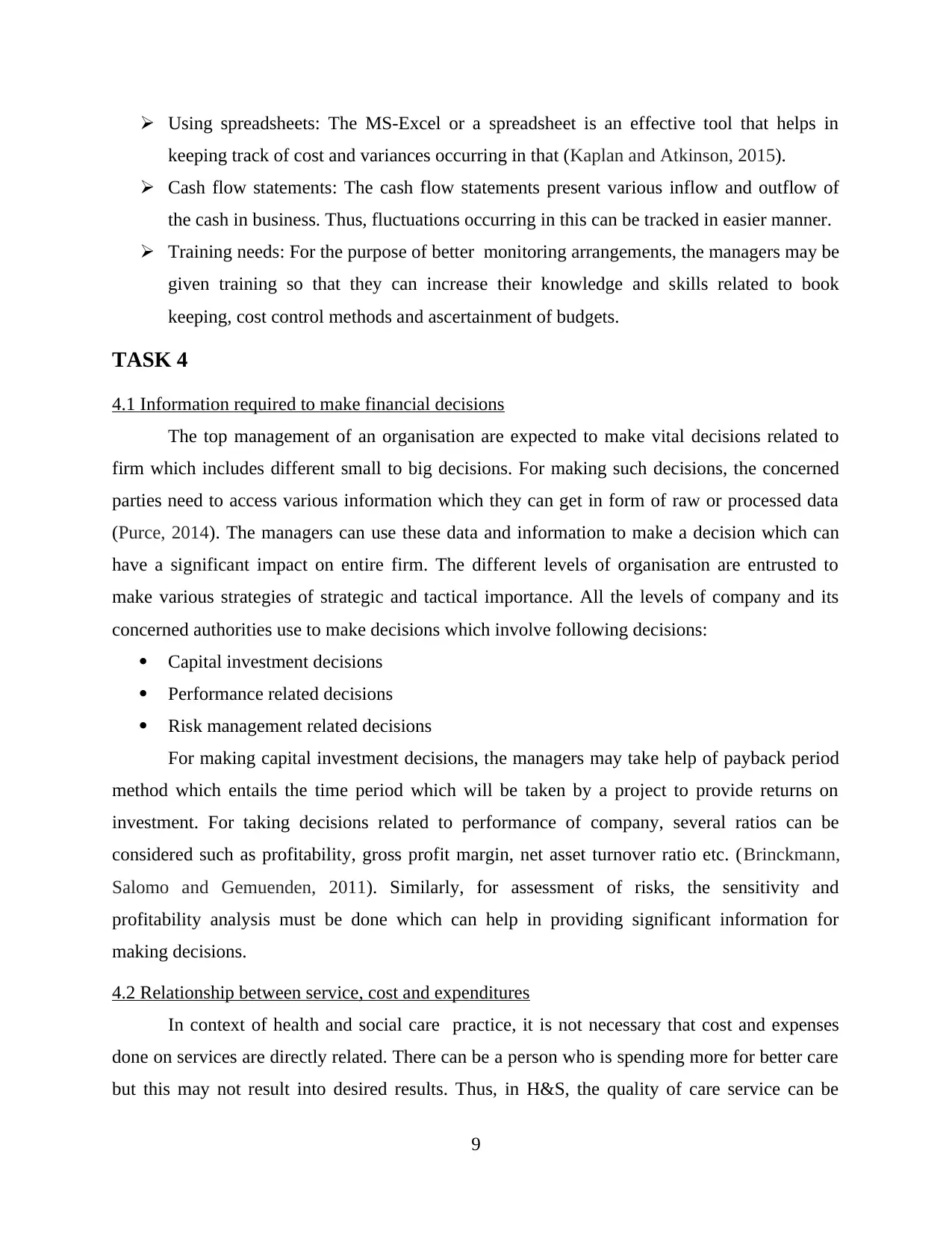
Using spreadsheets: The MS-Excel or a spreadsheet is an effective tool that helps in
keeping track of cost and variances occurring in that (Kaplan and Atkinson, 2015).
Cash flow statements: The cash flow statements present various inflow and outflow of
the cash in business. Thus, fluctuations occurring in this can be tracked in easier manner.
Training needs: For the purpose of better monitoring arrangements, the managers may be
given training so that they can increase their knowledge and skills related to book
keeping, cost control methods and ascertainment of budgets.
TASK 4
4.1 Information required to make financial decisions
The top management of an organisation are expected to make vital decisions related to
firm which includes different small to big decisions. For making such decisions, the concerned
parties need to access various information which they can get in form of raw or processed data
(Purce, 2014). The managers can use these data and information to make a decision which can
have a significant impact on entire firm. The different levels of organisation are entrusted to
make various strategies of strategic and tactical importance. All the levels of company and its
concerned authorities use to make decisions which involve following decisions:
Capital investment decisions
Performance related decisions
Risk management related decisions
For making capital investment decisions, the managers may take help of payback period
method which entails the time period which will be taken by a project to provide returns on
investment. For taking decisions related to performance of company, several ratios can be
considered such as profitability, gross profit margin, net asset turnover ratio etc. (Brinckmann,
Salomo and Gemuenden, 2011). Similarly, for assessment of risks, the sensitivity and
profitability analysis must be done which can help in providing significant information for
making decisions.
4.2 Relationship between service, cost and expenditures
In context of health and social care practice, it is not necessary that cost and expenses
done on services are directly related. There can be a person who is spending more for better care
but this may not result into desired results. Thus, in H&S, the quality of care service can be
9
keeping track of cost and variances occurring in that (Kaplan and Atkinson, 2015).
Cash flow statements: The cash flow statements present various inflow and outflow of
the cash in business. Thus, fluctuations occurring in this can be tracked in easier manner.
Training needs: For the purpose of better monitoring arrangements, the managers may be
given training so that they can increase their knowledge and skills related to book
keeping, cost control methods and ascertainment of budgets.
TASK 4
4.1 Information required to make financial decisions
The top management of an organisation are expected to make vital decisions related to
firm which includes different small to big decisions. For making such decisions, the concerned
parties need to access various information which they can get in form of raw or processed data
(Purce, 2014). The managers can use these data and information to make a decision which can
have a significant impact on entire firm. The different levels of organisation are entrusted to
make various strategies of strategic and tactical importance. All the levels of company and its
concerned authorities use to make decisions which involve following decisions:
Capital investment decisions
Performance related decisions
Risk management related decisions
For making capital investment decisions, the managers may take help of payback period
method which entails the time period which will be taken by a project to provide returns on
investment. For taking decisions related to performance of company, several ratios can be
considered such as profitability, gross profit margin, net asset turnover ratio etc. (Brinckmann,
Salomo and Gemuenden, 2011). Similarly, for assessment of risks, the sensitivity and
profitability analysis must be done which can help in providing significant information for
making decisions.
4.2 Relationship between service, cost and expenditures
In context of health and social care practice, it is not necessary that cost and expenses
done on services are directly related. There can be a person who is spending more for better care
but this may not result into desired results. Thus, in H&S, the quality of care service can be
9
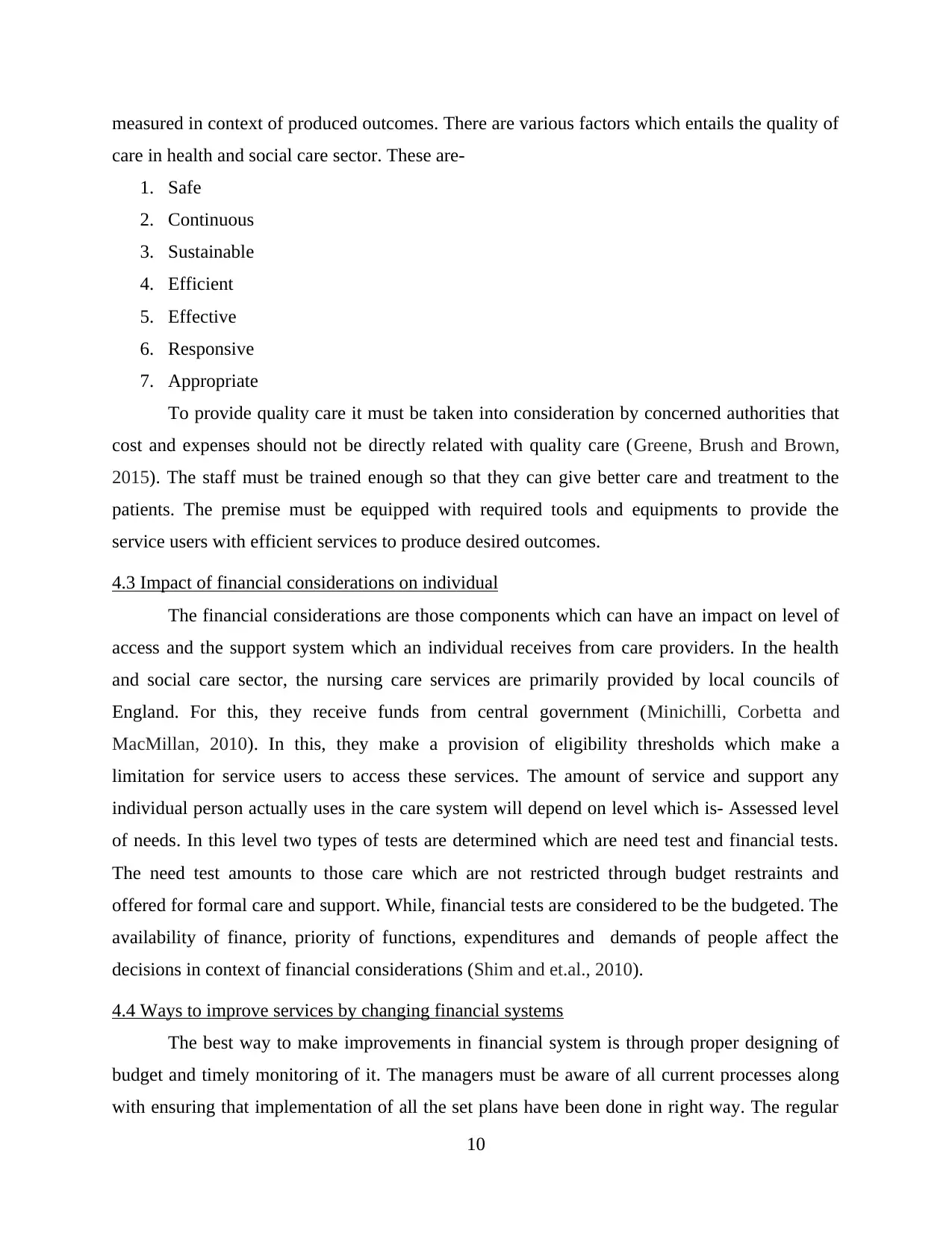
measured in context of produced outcomes. There are various factors which entails the quality of
care in health and social care sector. These are-
1. Safe
2. Continuous
3. Sustainable
4. Efficient
5. Effective
6. Responsive
7. Appropriate
To provide quality care it must be taken into consideration by concerned authorities that
cost and expenses should not be directly related with quality care (Greene, Brush and Brown,
2015). The staff must be trained enough so that they can give better care and treatment to the
patients. The premise must be equipped with required tools and equipments to provide the
service users with efficient services to produce desired outcomes.
4.3 Impact of financial considerations on individual
The financial considerations are those components which can have an impact on level of
access and the support system which an individual receives from care providers. In the health
and social care sector, the nursing care services are primarily provided by local councils of
England. For this, they receive funds from central government (Minichilli, Corbetta and
MacMillan, 2010). In this, they make a provision of eligibility thresholds which make a
limitation for service users to access these services. The amount of service and support any
individual person actually uses in the care system will depend on level which is- Assessed level
of needs. In this level two types of tests are determined which are need test and financial tests.
The need test amounts to those care which are not restricted through budget restraints and
offered for formal care and support. While, financial tests are considered to be the budgeted. The
availability of finance, priority of functions, expenditures and demands of people affect the
decisions in context of financial considerations (Shim and et.al., 2010).
4.4 Ways to improve services by changing financial systems
The best way to make improvements in financial system is through proper designing of
budget and timely monitoring of it. The managers must be aware of all current processes along
with ensuring that implementation of all the set plans have been done in right way. The regular
10
care in health and social care sector. These are-
1. Safe
2. Continuous
3. Sustainable
4. Efficient
5. Effective
6. Responsive
7. Appropriate
To provide quality care it must be taken into consideration by concerned authorities that
cost and expenses should not be directly related with quality care (Greene, Brush and Brown,
2015). The staff must be trained enough so that they can give better care and treatment to the
patients. The premise must be equipped with required tools and equipments to provide the
service users with efficient services to produce desired outcomes.
4.3 Impact of financial considerations on individual
The financial considerations are those components which can have an impact on level of
access and the support system which an individual receives from care providers. In the health
and social care sector, the nursing care services are primarily provided by local councils of
England. For this, they receive funds from central government (Minichilli, Corbetta and
MacMillan, 2010). In this, they make a provision of eligibility thresholds which make a
limitation for service users to access these services. The amount of service and support any
individual person actually uses in the care system will depend on level which is- Assessed level
of needs. In this level two types of tests are determined which are need test and financial tests.
The need test amounts to those care which are not restricted through budget restraints and
offered for formal care and support. While, financial tests are considered to be the budgeted. The
availability of finance, priority of functions, expenditures and demands of people affect the
decisions in context of financial considerations (Shim and et.al., 2010).
4.4 Ways to improve services by changing financial systems
The best way to make improvements in financial system is through proper designing of
budget and timely monitoring of it. The managers must be aware of all current processes along
with ensuring that implementation of all the set plans have been done in right way. The regular
10
Paraphrase This Document
Need a fresh take? Get an instant paraphrase of this document with our AI Paraphraser
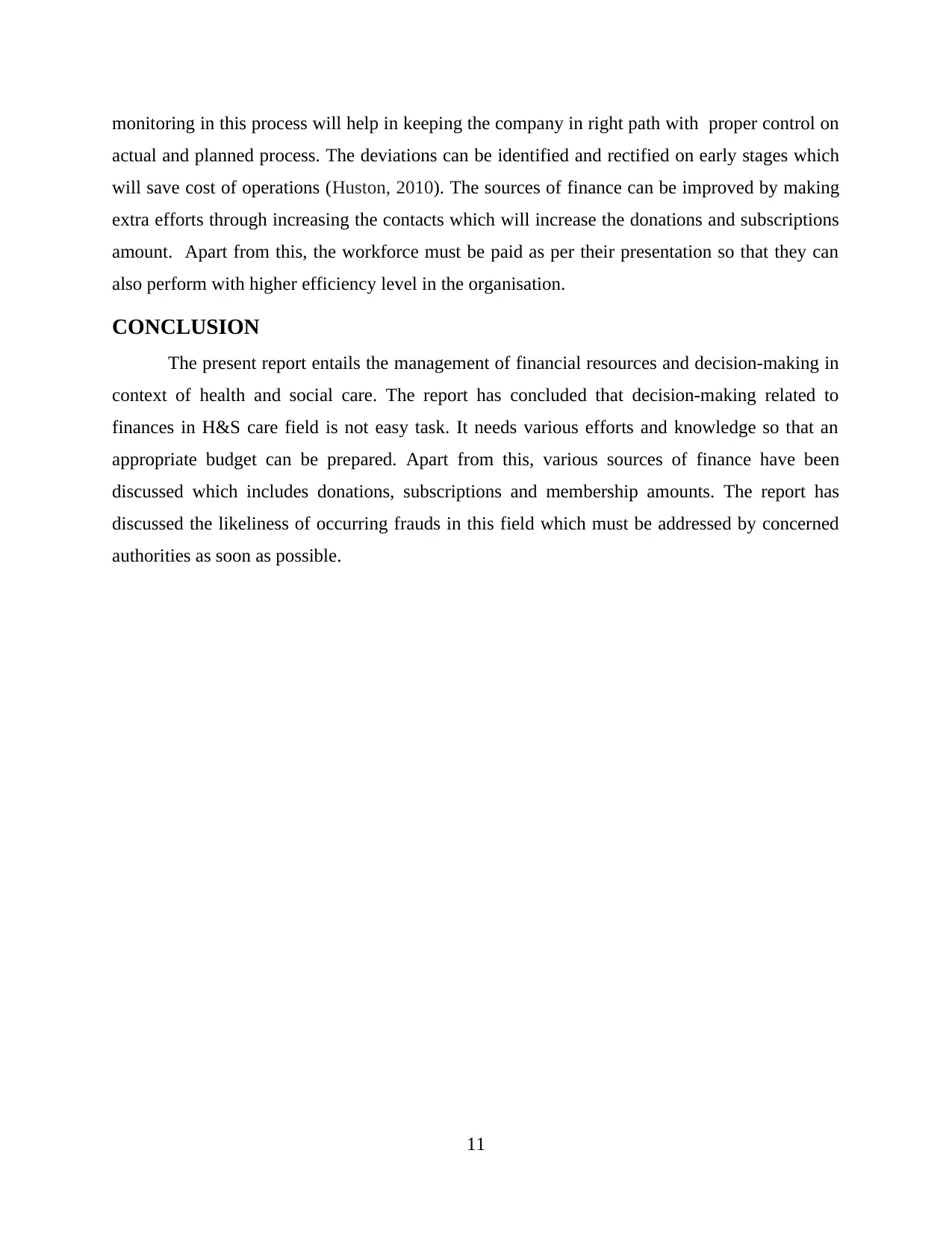
monitoring in this process will help in keeping the company in right path with proper control on
actual and planned process. The deviations can be identified and rectified on early stages which
will save cost of operations (Huston, 2010). The sources of finance can be improved by making
extra efforts through increasing the contacts which will increase the donations and subscriptions
amount. Apart from this, the workforce must be paid as per their presentation so that they can
also perform with higher efficiency level in the organisation.
CONCLUSION
The present report entails the management of financial resources and decision-making in
context of health and social care. The report has concluded that decision-making related to
finances in H&S care field is not easy task. It needs various efforts and knowledge so that an
appropriate budget can be prepared. Apart from this, various sources of finance have been
discussed which includes donations, subscriptions and membership amounts. The report has
discussed the likeliness of occurring frauds in this field which must be addressed by concerned
authorities as soon as possible.
11
actual and planned process. The deviations can be identified and rectified on early stages which
will save cost of operations (Huston, 2010). The sources of finance can be improved by making
extra efforts through increasing the contacts which will increase the donations and subscriptions
amount. Apart from this, the workforce must be paid as per their presentation so that they can
also perform with higher efficiency level in the organisation.
CONCLUSION
The present report entails the management of financial resources and decision-making in
context of health and social care. The report has concluded that decision-making related to
finances in H&S care field is not easy task. It needs various efforts and knowledge so that an
appropriate budget can be prepared. Apart from this, various sources of finance have been
discussed which includes donations, subscriptions and membership amounts. The report has
discussed the likeliness of occurring frauds in this field which must be addressed by concerned
authorities as soon as possible.
11
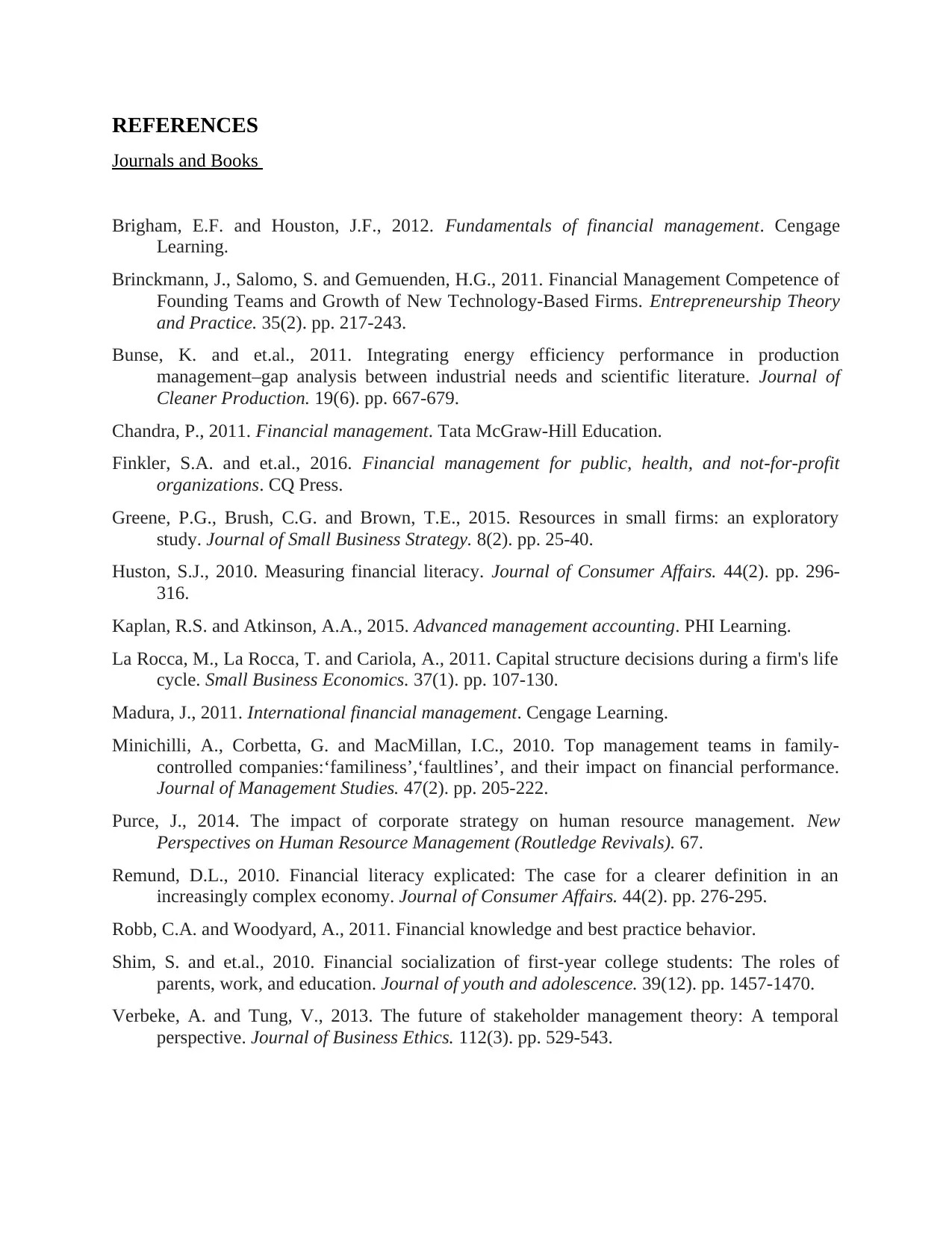
REFERENCES
Journals and Books
Brigham, E.F. and Houston, J.F., 2012. Fundamentals of financial management. Cengage
Learning.
Brinckmann, J., Salomo, S. and Gemuenden, H.G., 2011. Financial Management Competence of
Founding Teams and Growth of New Technology‐Based Firms. Entrepreneurship Theory
and Practice. 35(2). pp. 217-243.
Bunse, K. and et.al., 2011. Integrating energy efficiency performance in production
management–gap analysis between industrial needs and scientific literature. Journal of
Cleaner Production. 19(6). pp. 667-679.
Chandra, P., 2011. Financial management. Tata McGraw-Hill Education.
Finkler, S.A. and et.al., 2016. Financial management for public, health, and not-for-profit
organizations. CQ Press.
Greene, P.G., Brush, C.G. and Brown, T.E., 2015. Resources in small firms: an exploratory
study. Journal of Small Business Strategy. 8(2). pp. 25-40.
Huston, S.J., 2010. Measuring financial literacy. Journal of Consumer Affairs. 44(2). pp. 296-
316.
Kaplan, R.S. and Atkinson, A.A., 2015. Advanced management accounting. PHI Learning.
La Rocca, M., La Rocca, T. and Cariola, A., 2011. Capital structure decisions during a firm's life
cycle. Small Business Economics. 37(1). pp. 107-130.
Madura, J., 2011. International financial management. Cengage Learning.
Minichilli, A., Corbetta, G. and MacMillan, I.C., 2010. Top management teams in family‐
controlled companies:‘familiness’,‘faultlines’, and their impact on financial performance.
Journal of Management Studies. 47(2). pp. 205-222.
Purce, J., 2014. The impact of corporate strategy on human resource management. New
Perspectives on Human Resource Management (Routledge Revivals). 67.
Remund, D.L., 2010. Financial literacy explicated: The case for a clearer definition in an
increasingly complex economy. Journal of Consumer Affairs. 44(2). pp. 276-295.
Robb, C.A. and Woodyard, A., 2011. Financial knowledge and best practice behavior.
Shim, S. and et.al., 2010. Financial socialization of first-year college students: The roles of
parents, work, and education. Journal of youth and adolescence. 39(12). pp. 1457-1470.
Verbeke, A. and Tung, V., 2013. The future of stakeholder management theory: A temporal
perspective. Journal of Business Ethics. 112(3). pp. 529-543.
Journals and Books
Brigham, E.F. and Houston, J.F., 2012. Fundamentals of financial management. Cengage
Learning.
Brinckmann, J., Salomo, S. and Gemuenden, H.G., 2011. Financial Management Competence of
Founding Teams and Growth of New Technology‐Based Firms. Entrepreneurship Theory
and Practice. 35(2). pp. 217-243.
Bunse, K. and et.al., 2011. Integrating energy efficiency performance in production
management–gap analysis between industrial needs and scientific literature. Journal of
Cleaner Production. 19(6). pp. 667-679.
Chandra, P., 2011. Financial management. Tata McGraw-Hill Education.
Finkler, S.A. and et.al., 2016. Financial management for public, health, and not-for-profit
organizations. CQ Press.
Greene, P.G., Brush, C.G. and Brown, T.E., 2015. Resources in small firms: an exploratory
study. Journal of Small Business Strategy. 8(2). pp. 25-40.
Huston, S.J., 2010. Measuring financial literacy. Journal of Consumer Affairs. 44(2). pp. 296-
316.
Kaplan, R.S. and Atkinson, A.A., 2015. Advanced management accounting. PHI Learning.
La Rocca, M., La Rocca, T. and Cariola, A., 2011. Capital structure decisions during a firm's life
cycle. Small Business Economics. 37(1). pp. 107-130.
Madura, J., 2011. International financial management. Cengage Learning.
Minichilli, A., Corbetta, G. and MacMillan, I.C., 2010. Top management teams in family‐
controlled companies:‘familiness’,‘faultlines’, and their impact on financial performance.
Journal of Management Studies. 47(2). pp. 205-222.
Purce, J., 2014. The impact of corporate strategy on human resource management. New
Perspectives on Human Resource Management (Routledge Revivals). 67.
Remund, D.L., 2010. Financial literacy explicated: The case for a clearer definition in an
increasingly complex economy. Journal of Consumer Affairs. 44(2). pp. 276-295.
Robb, C.A. and Woodyard, A., 2011. Financial knowledge and best practice behavior.
Shim, S. and et.al., 2010. Financial socialization of first-year college students: The roles of
parents, work, and education. Journal of youth and adolescence. 39(12). pp. 1457-1470.
Verbeke, A. and Tung, V., 2013. The future of stakeholder management theory: A temporal
perspective. Journal of Business Ethics. 112(3). pp. 529-543.
1 out of 15
Related Documents
Your All-in-One AI-Powered Toolkit for Academic Success.
+13062052269
info@desklib.com
Available 24*7 on WhatsApp / Email
![[object Object]](/_next/static/media/star-bottom.7253800d.svg)
Unlock your academic potential
© 2024 | Zucol Services PVT LTD | All rights reserved.





